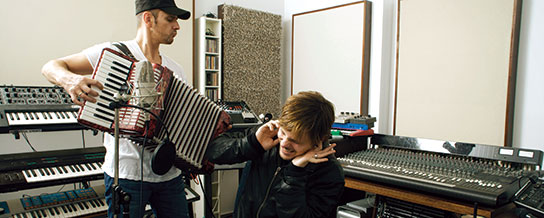In the Studio: Booka Shade
When artists rail on about subtlety and stepping away from the almighty riff, a red […]

In the Studio: Booka Shade
When artists rail on about subtlety and stepping away from the almighty riff, a red […]

When artists rail on about subtlety and stepping away from the almighty riff, a red flag tends to go up. In the case of Berlin’s Booka Shade, though, careful refinement has always been part of their 20-year-plus process. With their roots in synth-pop bands, producer Walter Merziger and drummer Arno Kammermeier have always erred on the side of stripped-back groove, long before minimal techno made it fashionable. Booka Shade’s latest album, The Sun and the Neon Light, has the familiar weight of their breakout release, Movements, but with a more spacious, experimental edge. Tracks like “Psychameleon” trade house’s pulse for a glittery swing, built from a malfunctioning Korg Poly-800 synth and a vocoded whisper. It’s a sound that can be delicate, but never thin–a change at least partially due to the duo’s renewed interest in vintage hardware and acoustic instruments. Here they talk about the benefits of dragging 600 lbs. of gear clear across the ocean.
XLR8R: Does the term “electro-house” make any sense regarding what you do?
Arno Kammermeier: When a name for a style is found, you’re already lost. People start working with a strict formula, the beats get too hard, and it stops being sexy. Similarly, on Movements, all the songs were riff-oriented, and we felt like that was done. On The Sun and the Neon Light, we decided to find a different way. One of the first things we did was a song called “Duke.” It’s darker, more cinematic, and it has this little hook–it sounds more like something from our first album, Memento.
What’s the draw of stepping outside of purely computer-based production?
Walter Merziger: For one, analog synthesizers don’t always work in the same way. You hit one key and it sounds this way; you hit it again and it sounds totally different. It depends on so many things, even the temperature of the room. But since we do use plug-ins sometimes, we might run the sound through an amp or speakers and mic it to get the sound of the room. If it’s low in the mix, sometimes it works, sometimes it doesn’t, but it gives a certain texture that plug-ins don’t have.
Is there still a place for hardware compressors and effects in your setup?
WM: We have an LA-4 from UREI that’s good for bass sounds–if you need them more flat, for example. But really, I don’t hear that much of a difference between old compressors and the emulations. We had [vintage compressors] in the past–Tube-Techs and Fairchilds–and I know how they sound. But with [plug-ins] like Pro Tools’ Fairchild emulation, I can get very close to that sound.
How do you pull off your live performances?
WM: The thing you see most directly is Arno, because he is playing drums and the [Roland V-Drum] triggers. Keyboards aren’t as sexy in a live situation. But what I try to do is find a balance between playing and doing the things you can do with modern production, like with delays and EQs and Ableton [Live]–I manipulate those things live. If all I did was play the keyboards, I’d get bored… it’s too old-school. So I have a custom-made controller for Ableton, and I drop in loops and melodies from the clip page that go with 12 tracks on the arrangement page, where the bass and snare are on their own tracks. That goes into a Midas [mixing] desk, along with my keyboards, a [Roland] V-Synth, and a vocoder, so I can sing along with the melodies. A second computer runs Logic, and has all my plug-ins and samples on it, which I play from another keyboard. This way, I can play the riff of “Mandarine Girl,” and I can do little variations on whatever I want. I can decide it would be more fun to play around with audio clips, or a Korg Kaoss Pad, or just play keyboards. I have a lot of flexibility.
How do you tour with all that gear?
WM: It’s not easy! [Everything] weighs about 300 kg, and we take it from Bucharest to Lisbon to Glastonbury. We created custom cases to hold everything–cases in cases, because of how stuff gets thrown around on airplanes. And then there’s the sensitive things… we have four laptops, with visuals, LED lights, and keyboards that are all synchronized via MIDI. In the past we did 200 shows with our old setup and only had four crashes. So this year, we’re playing at these big festivals–Coachella and Lollapalooza–and we’re bringing all this gear. [Meanwhile] a band like Nine Inch Nails has 10 people setting up everything for them and a sound check. We have 15 minutes and just the two of us.

